
One of the Founding Fathers of Concert Touring Reflects on His Long Career“Every moment is a learning moment,” Doug Pope says. “I have a strong passion to teach or at least pass along any information I have to anyone who wants to learn. When I started working for Neil [Diamond], I was on the floor talking to the young guys on the crew and passing my knowledge to them.” Pope, one of the founding fathers of concert touring, deserves credit for not only his distinguished career, but for those who became better live event professionals because “the professor” would take the time to guide, answer questions and share his experience to anyone and everyone that wanted to know. Oh, and let’s take the quotes off the word, professor — he actually was one, building a successful career in academia before he left the classroom for the road.
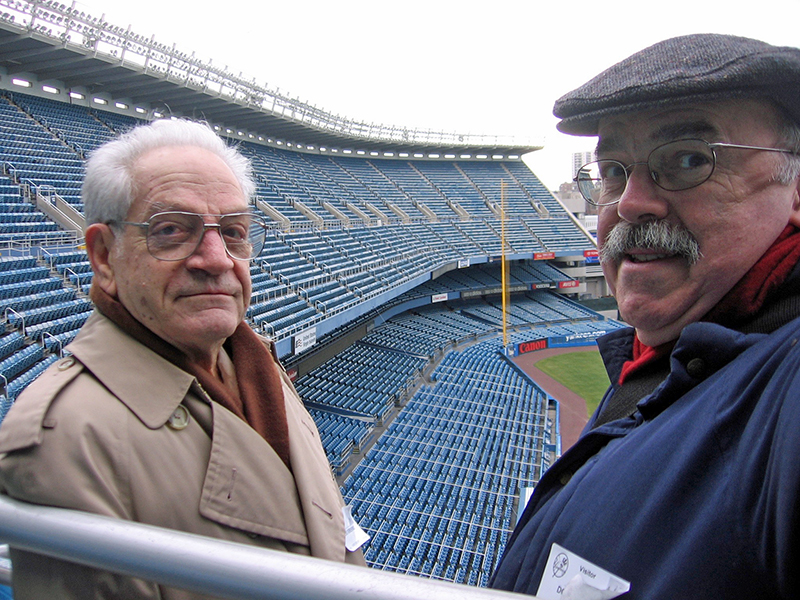
Born a Travelin’ Man
Doug Pope was born in St. Louis, but he didn’t spend much time there. In fact, for his first 18 years, he didn’t spend much time anywhere, moving nine times in that period. His father was a metallurgical engineer. “He worked in Chicago for a couple of years, Cleveland for a couple of years, and then New York, where I finished up high school,” he says. Pope attended what is now Carnegie Mellon University where he got a Bachelor’s and then a Master’s in Fine Arts. After graduating in 1965, he stayed on at Carnegie and taught for three years before moving to the theater department at the University of Michigan in Ann Arbor. In addition to teaching, he was production manager for an ambitious program. “I built and managed sets and stages for 11 major productions a year for three years, and I ended up doing lights on a lot of those shows too,” he says. “All my stage craft studies really came together there.” Three years later, he nabbed a prestigious teaching position at Boston University, where now he also taught lighting design. “I was newly married with one child, and when I think back on that salary, it was just okay,” Pope says. “When I got into the professional live event business, my salary doubled!”

And that happened in 1974, when he left academia and went to work for Tom Fields Associates, one of the founding event companies of this new “business” of concert touring. “One of the first tours I worked was a two-week one with Three Dog Night, and then I did a couple of weeks with the Beach Boys.” The 70’s were the “Wild West” of the business, and there are many stories to tell of things going horribly wrong. “We did one show at Yale University’s football stadium, and the promoter had only hired local kids as the crew for the load-in. They had no incentive to stay for load-out. So we begged some of those kids to help load-out, saying we’d drive them home. I learned how to drive a forklift that night!”
Meanwhile, an old college roommate, George Honchar, had also landed in this business and was working for Imero Fiorentino Associates in New York. Pope went there beginning a 20-plus year association with the esteemed company (“I even got a watch out of it,” he says, with a laugh. “In 1975, on Thanksgiving weekend, Neil [Diamond] comes to Fiorentino’s office to ‘audition’ us. He was looking for someone to design sets and lights for his next tour.” It was the beginning of a long relationship with the company and its people. “I went out as a carpenter, putting this horseshoe-shaped set together every night.” Pope did not stay a carpenter for long, soon working as stage manager and eventually handling production duties as well. But first he had to get through that first gig…
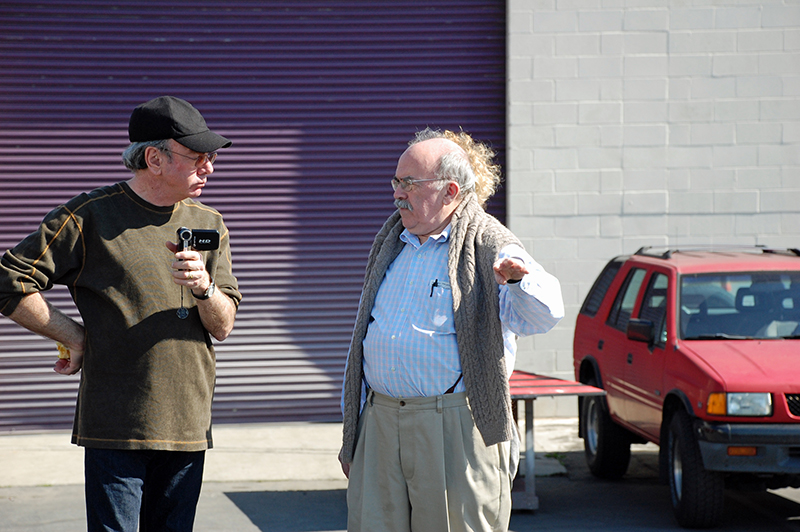
The Diamond Years
“After a frantic two months of preparation, we were ready to bring everything out on the road to those first shows in Utah in January 1976,” Pope says. In addition to carpenter duties, he was in charge with supervising the outdoor roof structure called the Mighty Mobius, which they then took to do shows in New Zealand and Australia. “I was naive enough to think that, after 10 weeks, I would be back in the office doing TV lighting work. Little did I know how that would turn out. Twenty-four years later, it’s 1999, when I withdrew from active touring after some 1,116 shows!” (Pope would return to pre-production work on Diamond tours, contributing often on shows — he just stayed off the road.)
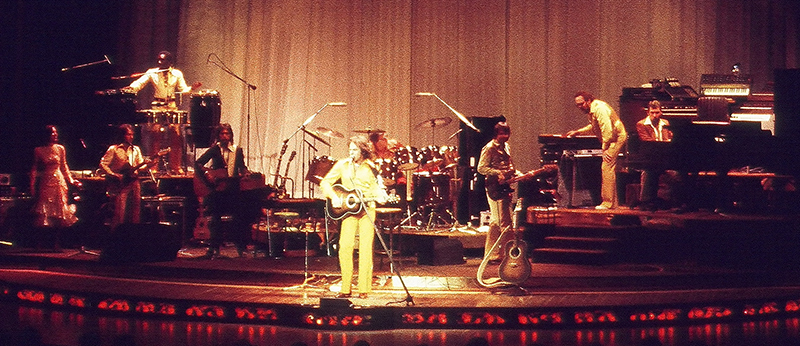
Pope lived through the many technological revolutions. “As time went on during those early years, we all got better at touring, better at life on the road and improvements in all aspects technical,” he says. “In the beginning, we had a simple set. Fairly easy to set up and take down. The lighting consisted of simple arched trusses holding brass plated PAR can light fixtures, all being supported by unstable hand crank-up lifts.” After a dangerous moment during a set up in Dallas that could have ended tragically, they moved to chain hoist motors to fly trusses. “Nowadays, those motors have become ‘smart motors’ and are able to raise and lower on demand, in order to achieve different looks with the repositioning of the lighting trusses. We don’t think anything of this technology now. It’s routine stuff.”
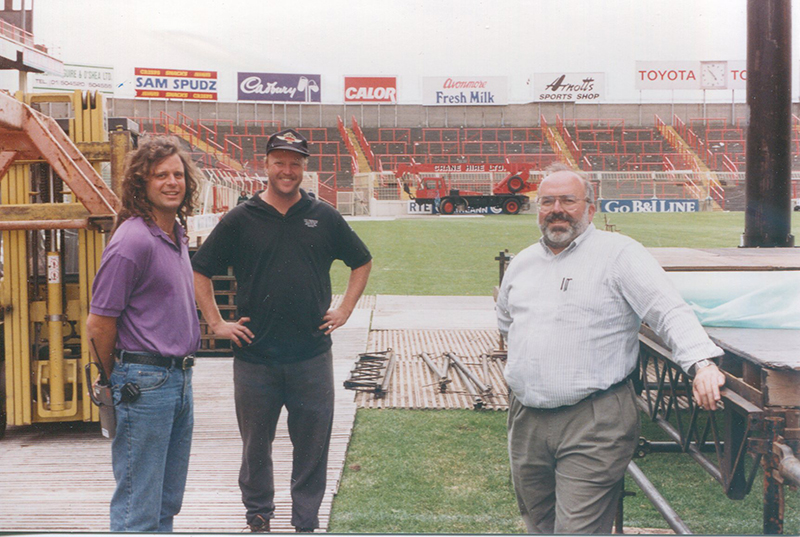
An early departure from simple staging was the use of a trap door in the center of the stage. “To achieve that, we had to have the venues build two stages six feet high with exactly four feet, one quarter inch apart, split along the center line. We’d walk into the hall at 6 a.m. and expect the stage to be properly arranged that way.” Usually, they got it right. “It was in Houston at The Summit that we walked in to find things spaced as requested, but they forgot to build the stage six feet high! How was Neil supposed to navigate that entrance from below with only five feet head clearance?” They gathered as many people as they could find at 6 a.m. to rebuild the stage. “Another potential stage catastrophe was at The Tacoma Dome, where they had positioned the stage four feet too far downstage. The rigging in the old days there was all three-point bridles coming from their unique dome structure. This was before their underhung grid was installed. I got a call at 2:30 in the morning at the hotel in Seattle alerting me to the problem. Off I went to Tacoma, where we got three forklifts to push this 60-by-40-foot stage upstage those four feet.”
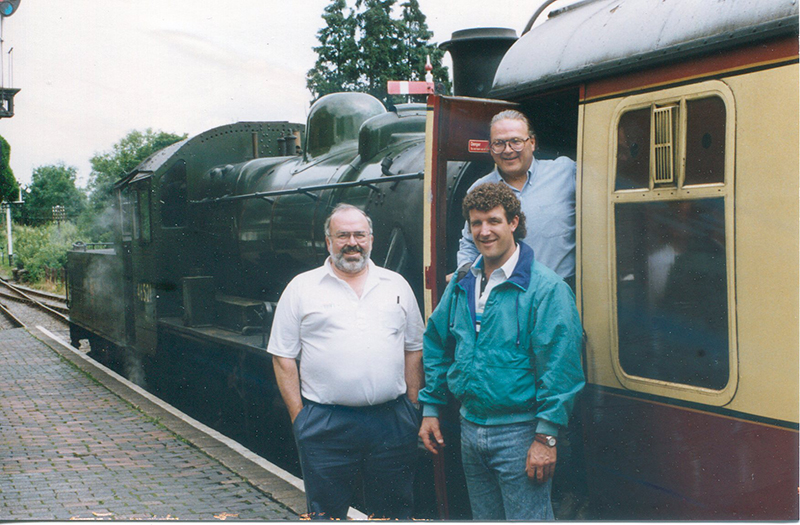
Pope was there when the idea of rolling stages happened. “While the crew was working on the stage construction, the lighting crew was busy working on top of the stage, rigging the chain hoists, lighting trusses and lights while the carpenters and others were waiting for lighting to finish so they could begin their work,” he says. “It was time wasted.” Stages on wheels were built on the arena floor, but not where it would end up. They were stocked, including the musical instruments and backline, all while the lighting crew was working on the floor where the stage would be rolled to. After lunch, the whole crew gathered round the stage and pushed it into place. He points out that rolling stages are still much in use. “And then they were made more efficient and fast erecting by the use of magnets! Tait Towers came up with this simple-but-brilliant way of holding all those stage pieces together.” Another innovation was the use of motorized stage platforms to close the gap at center stage after Diamond made his entrance and reopened when he exited.
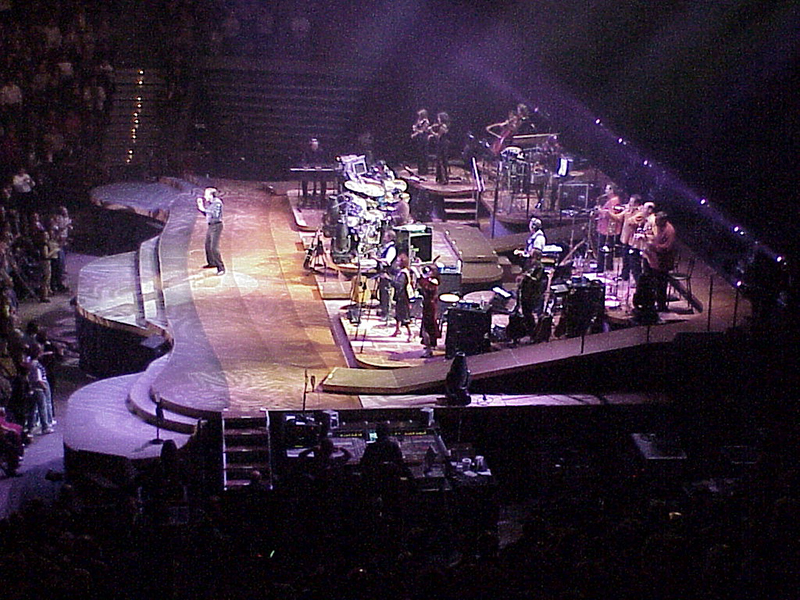
Lighting was evolving from theater-based products to gear that could stand up to the rigors of the road. Longtime Diamond LD Marilyn Lowry was always looking for that next best light with the most unusual effects. “The Panaspots were among the first really good moving light fixtures. They allowed for the repositioning of the beam and color changes to make some pretty dramatic looks on the stage. And now lighting is moving from a dichroic glass color filter in the fixture to a fixture powered by LED’s changing color.”
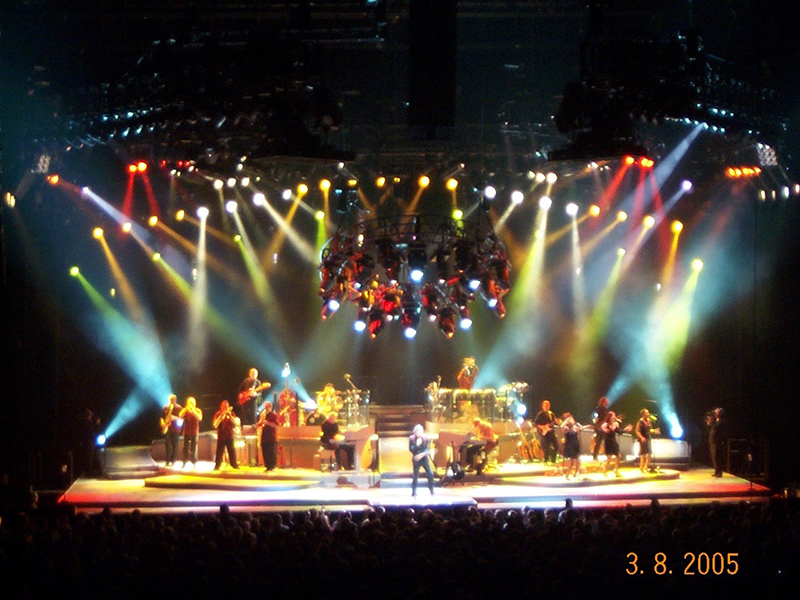
Diamond’s reputation of being good to his crew is something Pope confirms. “He once said to me that if there was anything I needed to make the touring situation a little better, I had his blessing to do whatever needed doing,” he says. “That was a lesson learned and followed.” Impressively — and no doubt contributing to his lengthy career and healthy life — Pope abstained from all the rock ‘n’ roll excesses of the 70’s and 80’s. “They were crazy times, but I’m probably straighter and squarer than most. There were a lot of problems with drugs that I observed going on, but that was something I never got into.”

Reflections
In those early days of live events, he also was the technical producer and production manager for numerous corporate clients, including Elizabeth Arden, MetLife, Xerox and Honda. Additional music production credits include site coordinator for live performances by Yanni in the Forbidden City in Beijing China and the Taj Mahal; technical director of “Elvis In Concert ‘97” and again in 2003; and technical director/production manager for the tour of “The Music of Andrew Lloyd Weber starring Sarah Brightman,” among others.
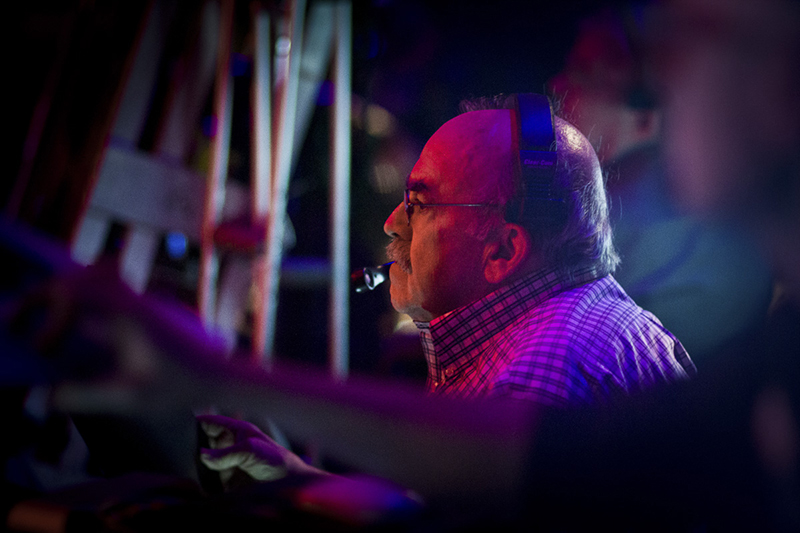
Pope also dabbled in the political arena, serving as production manager for the NYC Howard Dean Campaign Event in 2003 and as production consultant for the John Kerry Campaign Event in Los Angeles in 2004, the latter featuring Neil Diamond and Barbra Streisand. But Pope’s other grand achievement was … well, the Pope — twice. It was an opportunity for Doug Pope to work with Patrick Stansfield, Stig Edgren and other friends he had worked with through the year. The first “Pope Show” was the 1995 mass in Central Park, when Stansfield knighted him “Minister of Feet and Inches.”
Doug was the production supervisor for the Papal Visit and Mass at Yankee Stadium for the visit of Pope Benedict XVI in 2008. Sound problems in the stadium were solved when Doug suggested putting the speakers on top of the Mountain Productions roof structure to achieve a “point source” sound origination, thus bypassing the stadium’s ancient sound system completely. He’s also proud of the work he’s done with Joshua White and his Joshua Light Show. On a personal note, Pope was diagnosed with colorectal cancer in 1995, during that first Papal event. He completed his task while he endured chemo, and then in the following years, had additional operations and complications. Today, he’s been cancer-free for 14 years.
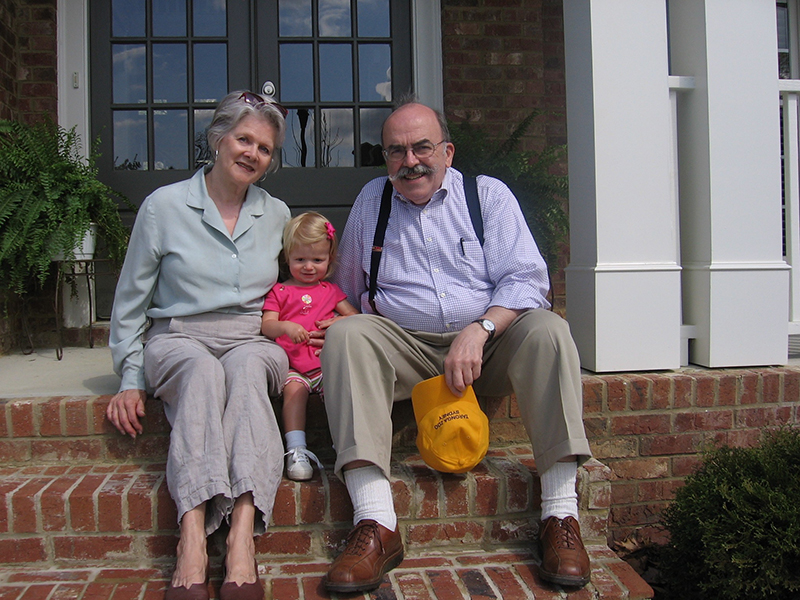
Reflecting back, he points out that the in the early days, “kids” went out on the road with no experience, but once there, they developed the skills they needed quickly — or went home. “Time sorted out people who were efficient and skilled. Many folks came and went from the touring life. Some were not that good and left the tour. Others left the tour to pursue other opportunities with their lives.” Pope never left — and made an enviable career of it all.


